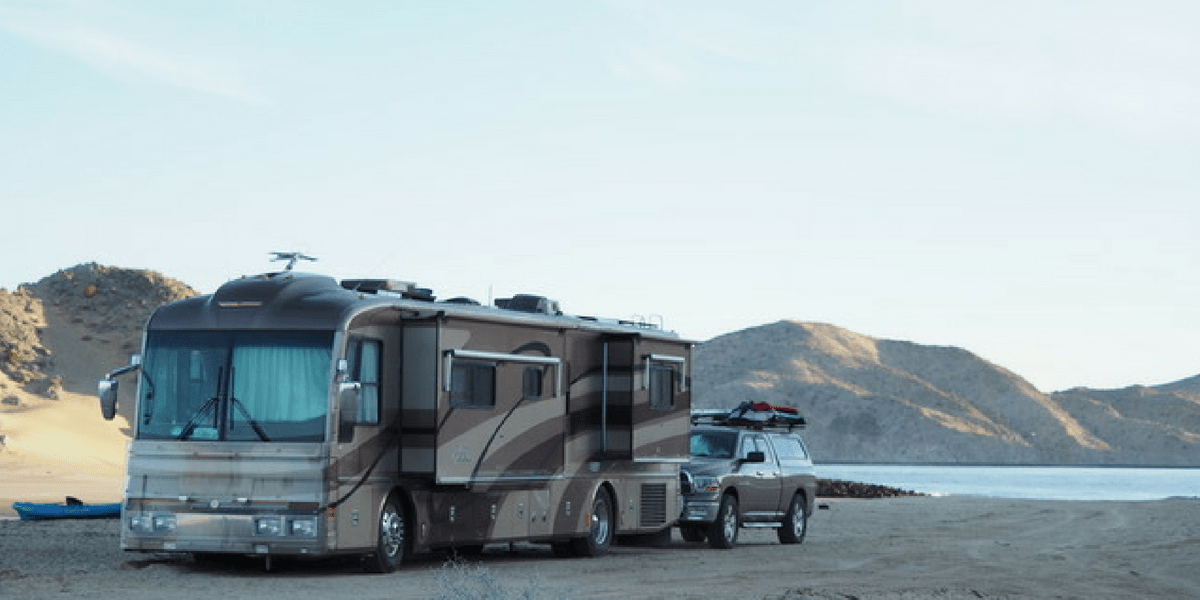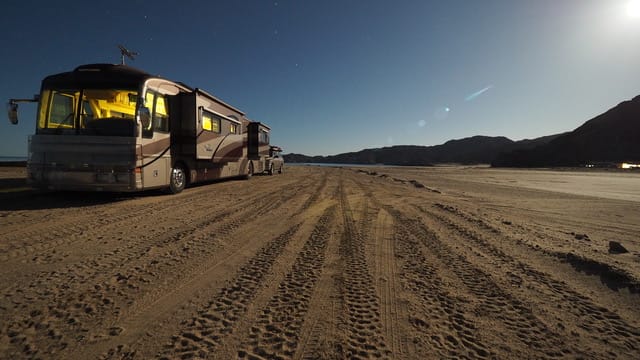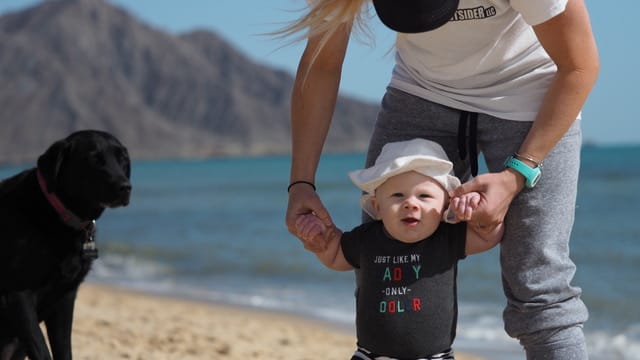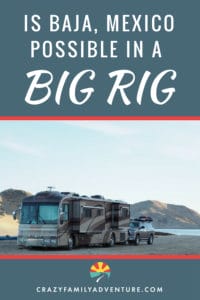We are so excited to have Jesse and Jenny from Outside Is Calling here to share their adventures traveling through Baja, Mexico in their 40 foot Diesel Pusher motorhome towing a pickup truck . . . yes you read that right! We totally didn’t think it was possible but after running into Jesse and Jenny in La Paz we were convinced it was! Here are the details on their trip RV Baja, California with a 40 foot motorhome and a baby!

Table of Contents
The BIG Idea
While visiting family in Florida, we made the mistake telling them our dream of traveling through Baja Mexico in our big RV. We’d tell them about the amazing beaches, incredible waves to surf, and the sunsets and margaritas that were beckoning us south of the border. The conversation typically went like this…
Mexico? In your RV? That’s crazy, haven’t you heard about all those kidnappings and drug wars down there?
No that’s mainland Mexico.
But Baja is part of Mexico. They could easily cross that big lake and come get you, maybe even kidnap Tucker. A beautiful girl and a baby, plus that big shiny RV, you’re asking for trouble.
Lake? You mean the Sea of Cortez? Yes we could get some unwanted attention in Baja but that could happen anywhere we travel.
Read our post: Is Baja, Mexico Safe
Well I don’t think it’s a good idea. You guys need to be careful, it’s too dangerous in Mexico. You should just stay here where it’s safe. There’s room HERE for your RV!
We might as well beat our heads against the wall. Why couldn’t our families understand how fun and amazing this trip to Baja would be. But maybe they were right? Our research hadn’t uncovered much information about big rigs in Mexico.
On YouTube there were dozens of vanlife travel videos, but only a few with actual RV’s. And those RV’s were less than 25 feet long. Our RV is 40 feet in length, not including the dirtbike and truck we tow behind us! The more we spoke with family and friends the more it seemed our plan wasn’t realistic.
There’s a saying that if you think you can, or if you think you can’t, you’re right. We continued researching until one day a book popped up in my Amazon search results. “Traveler’s Guide to Camping Mexico’s Baja” sounded like a guide for tent camping, but there on the cover were pictures of a few RV’s, one of them large like ours. In a frenzy I quickly read the description and jumped to my feet as I read the words, “Explore Baja… with your RV or Tent.” Wahoo, I found it!
For anyone thinking about visiting Baja in an RV, Mike and Terri Church’s book, “Traveler’s Guide to Camping Mexico’s Baja” should be the first thing you purchase. The book covers border crossings, rules, regulations, and a slew of other great information that will help with this amazing journey.
Houston We Have Liftoff
Just as the book recommended, we found an RV park in California, United States nearby the Mexicali East border crossing (also a great location to grab last minute spare parts or anything else you need). There are two Mexicali locations to cross, but the east one is further from town and quieter. Both good things when you’re traveling in a large house with wheels. The book recommends having all Mexican insurance, permits, and animal certificates ready, and to cross the border very early in the morning.
The next morning we reviewed our paperwork before shoving off, and Jenny discovered a massive error on our vehicle insurance. Our names were incorrect on the insurance forms and Discover Baja, whom we’d purchased insurance through, wasn’t open that early in the morning. The travel book was clear that everything needed to match; names, registration, insurance, etc.
What now, would we have to wait at the RV park until Monday? We called to extend our stay at the RV park and learned there was no space available, an air show was in town for the weekend. In a miraculous turn of events, Jenny’s Facebook message to Discover Baja was seen, despite being closed, and they replied several minutes later. After just a few minutes, Carol had corrected and emailed new insurance forms to us. The time was now 10AM. The book said it was vital to cross very early…
For us, life often seems like one big perpetual curveball. Few things ever go as planned, and this time we were left wondering if crossing so late would land us in the sprawling Mexican town of Mexicali after dark. You never drive after dark, a common theme in ALL our information gathering for Baja. But we couldn’t stay where we were either. Crossing late seemed like the lesser of two evils and we boogied on down to the border.
The last mile in the U.S. was eerily quiet. Only one small car passed by, and just a handful of Mexican border agents were at the checkpoint. It was so quiet in fact, that they had me stop the RV right in the middle of the thoroughfare for the inspection.
Within a half hour our passports were stamped, visitor permits signed, and we began heading south to San Felipe with plenty of daylight to spare. By driving slowly and carefully we had no problems getting all 65 feet of our rig through Mexicali. In fact, the town is built for semi truck traffic so the turn lanes offered plenty of room.
So many people have asked us about the border crossing that we made a video about it HERE:
Details, Details…
If you find yourself considering a visit to Baja and you too have a large RV, here’s what we learned and our recommendations on how it could be done better.
CELL SERVICE
For anyone hoping to use their phone’s navigation, be sure your carrier works in Baja. Sprint did not, so we switched a few weeks earlier to Verizon who has partnered with Baja cellular networks like TELCEL and Movistar. Our phone’s navigation quickly directed us through Mexicali and we began to relax as the city streets gave way to winding desert highway with jagged mountains in the distance.
Read our post: The Secret To The Best Baja Internet To Keep You Online
RV PARKS & CAMPING
For us, the whole point of traveling to Baja was to enjoy beach life and to have our RV steps away. You’ll see plenty of photos with RV’s alongside beautiful beaches, but more often than not those places require Dry Camping or complete Boondocking.
RV Parks
While there are many RV parks throughout Baja with full hookups, very few of them are nearby beaches. We did spend a few nights hooked up at RV parks, and prices ranged from $20-$30 per night. Our strategy was to spend time boondocking at remote beaches and then to hit an RV park for a night for the dump station, refill water, and then head back to the beach.
In Todos Santos we stayed at El Litro RV Park, and in La Paz we stayed at Campestre Maranatha (where we finally crossed paths with CrazyFamilyAdventure!!) At each RV park we’d detach our tow vehicle, then pull our large RV into its spot for the night. El Litro had some really sketchy looking power outlets and even Craig (@CrazyFamilyAdventure) mentioned he experienced power issues there.
Our RV has a Hughes Autoformer Power Booster, which helps with voltage issues (which isn’t uncommon in Baja according to our travel book). We did not experience any issues with power but did use extra caution with water. Between the park’s water source and our RV’s water intake we installed a carbon filter which can be found for about $20 at most RV stores. We still wouldn’t drink this filtered water but this helped keep any “crud” out of our tank.
Dry Camping
Some of the best Dry Camping spots (and beach camping) are along Bahia Conception, most around $200 Pesos per day ($11 US). Several times a day you’ll have vendors swing by offering baked goods, fresh seafood, Mexican crafts, and more importantly, water to fill your RV tanks along with a mobile septic service.
We stayed at Playa Santispac, which offers the easiest beach access. We didn’t need our tanks pumped so aren’t sure the cost, however we did purchase one 55 gallon tank of water for $150 Pesos ($8 US) which topped off our 100 gallon tank allowing indulgences like longer hot showers. Note that questionable water should only be used for bathing. We were told water from the 55gallon tank was potable, but the standard in Baja is to purchase a 5 gallon jug of purified water and use ONLY that for drinking/making ice. Refills for our 5 gallon jug (called a garifuna) ranged from $.50 to $1.00 US.
Boondocking
Now THIS is what has likely drawn you to visit Baja. Photos of palm trees, clear water, and uncrowded beaches. These places do exist, but you’ll need to bring everything along for your time at the beach, desert oasis, mountain retreat, or whatever version of Baja suits you. It might seem overwhelming or almost impossible, but it’s actually pretty easy once you get a few things in place.
Another component which made boondocking our #1 choice was how relaxed Mexicans are. So long as there aren’t no trespassing signs posted (which most often accompanied gringo property) we would find a clear, flat place to camp nearby the beach we were visiting.
Power – We installed a massive solar array before visiting Baja, 1120 watts. Each day our battery bank would be recharged by lunch time, and we could use most appliances throughout the day as normal. This helped with meals, as we could use the Convection Oven for baking if needed without cranking up the generator (helloooooo pizzas!).
In short, every penny spent on solar is worth it in Baja. Determine how much power you’ll consume overnight and base your solar/battery system on that. For those wondering, we have 1120 watts of solar (4 panels x280 watts each) and the common battery bank found in RV’s. That’s 4x 6volt batteries configured in series parallel (a wiring configuration that essentially turns them into one big honkin’ 12 volt battery). We currently have Trojan T145 batteries.
Water – learn the art of the trickle. We took “trickle showers”. Since our shower head has a pressure valve we were able to have the water set to a warm temperature but only allow small amounts of water to come through at once. Also, when cooking it helps to use as few dishes as possible to avoid long clean-ups (read: water-intensive). We grilled as much as possible and would try to use one pot/pan when cooking.
Food – figure out what your staple meals are, and keep those ingredients in stock. We have a handful of meals that we always seem to gravitate towards, and it helps to not have to put much thought into planning a meal when you’re camping on a beach in Mexico. Steak and potatoes are a fav of ours, and both of those items are cooked on the grill (little to no cleanup!).
Pair that with a salad and we’re happy campers. We also discovered the Crock Pot uses very little power, and so throwing something in there and letting it cook all day is an effective use of power and time. We do not have one, but have heard great things about the InstaPots as well.
Entertainment – you’ll often find, at least in Baja, that these picturesque boondocking locations also do not have cell coverage…or WiFi. We love a good movie night, and so we lugged a CD case of hard copy DVD’s with us. Pre-downloaded podcasts, songs, and audio books are a good idea. We’ve also heard of card games and puzzles, but aren’t sure of you can find those nearly extinct items any longer 😉
Lessons Learned
We could bore you to death with every little detail, so instead we’ll share a few of the places we visited and how we made each one work.
Read our post: What You Need To Do To Prepare For A Badass Baja Mexico Trip
Gonzaga Bay
G-Bay’s full name is Bahia San Luis Gonzaga, and it’s a few hours south of San Felipe on the Sea of Cortez. Our first dry camping spot, it was essentially a gated community with probably 30 to 40 off-grid homes, most owned by Californian gringos. Just past the community however is a long beach leading out to a beautiful island. At low tide you can walk to the island with dry feet, but you’d have to swim at high tide. In short, it was an incredibly beautiful place, and totally worth the visit.
We had to pay $200 Pesos ($11 US) per night. Not the cheapest option in Baja but when you consider the fact that it’s safer and there are far less campers since it isn’t free, we thought it was a good value. Given more time we would’ve stayed longer but we’d still be limited by our water supply.
For hardcore boondockers you could easily bathe in the sea, and only head into town for drinking water. Like many of the best places in Baja there was no wifi AND no cell service, OUCH! Since I have both school and YouTube work to complete every week our time was limited. For those that desire a chance to escape those parts of our busy lives however, this would be one of my top 5 recommendations for you.
Check out our Gonzaga Bay video here:
Todos Santos, El Litro RV Park
Our guidebook stated that El Litro was nice because it had an authentic Mexican feel due to its location (this is in Baja California Sur). What that really meant was the RV park is down a dusty, dirt road. Deep in the local community where music is played well into the night and a chorus of dogs bark 24 hours a day. Not to sound pretentious, but we’d just spent a few weeks alongside beautiful beaches with only the sounds of waves lapping the shore.
This place felt like New York City in comparison. The short walk to shopping and food makes up for some of these pitfalls. Although there were no beaches within walking distance, a deal-breaker for us. You could also visit Cabo San Lucas from here for the day.
As mentioned earlier, a voltage regulator of some sort would make the power at El Litro safe for your RV. Once again the city water is questionable. We were recommended NOT to drink it, especially with a baby onboard, and to use it only for washing. I think you’ll quickly find that carrying a 5 gallon jug for purified drinking water is the simplest solution.
That way, you can just use whatever water you find to fill your RV water tank. And still know that you have water safe for drinking in the jug. It’s also important to note, that despite all this talk of safe and unsafe water, not once during our time in Baja did any of us feel ill. Not even our 9 month old baby. The RV book states that they just add some bleach (free of other chemicals) to each tank of questionable water. So don’t let all this talk about safe or unsafe water turn you away from what will be an amazing trip you’ll never forget.
Nearly every town has a propane station, typically on the outskirts of town. In san Felipe we saw RVers who had a propane truck deliver to them. Since propane is the standard for heating water and cooking in Baja, propane is readily available for your RV in many places. The App, I-Overlander was useful whenever we needed to find propane.
JUST GO!
Are you still wondering if Baja is too difficult? All we did was read a couple books, prepare some documents, and drive our RV south. So long as you take the recommended steps, all spelled out in various travel resources, it really wasn’t a hard place to travel. And RV camping in Baja is totally doable. The Baja peninsula is gorgeous.
There were definitely times where we felt the pressure of having such a large rig. There’s this perfect beach, just north of Todos Santos. Due to low power lines, tight turns, and steep “vados”, it was unfortunately a no-go for us to camp there. Towns, too, were always interesting to drive through. We’d try to always look ahead on Google Maps to see if there were any tight squeezes ahead of us. Also driving in the daylight hours is a must in Baja.
Generally, we knew where we were staying and we’d made sure ahead of time that our rig would fit (calling the RV park or researching boondocking locations). We spent a few nights on the side of the highway. In those situations, we’d keep an eye out for a large pull off/parking area that truckers use. Only once did we drive down a road without knowing what to expect, and luckily it turned out fine! You can see that video HERE .
As for the “tight” roads…we never got around to it. But Jesse wanted to strap a GoPro to his side mirror to give viewers a feel of how close other rigs and semi-trucks got to us. Most everyone would slow down and hug the lip, but they certainly are tight!
We didn’t have any issues getting Diesel. Jesse would look before pulling in to make sure we could maneuver well enough to not need to decouple. Our rig doesn’t require DEF (Diesel Exhaust Fluid) so we didn’t have to worry about that.
Some people have asked if we were uncomfortable in a “flashy” rig, and we can honestly answer no. Mind you, we never left it unattended or not within eyesight while in a bigger town or city. Would we do it again? Absolutely! Our rig earned a few nicks and scratches. Jesse may have lost a year off his life from maneuvering the potholes, BUT it was an experience we loved and we had our home with us the whole time.
If you have a big rig and want to visit Baja, DO IT! (just do your research and please don’t blame us if you get stuck anywhere 😉
We’ll continue uploading YouTube videos from our trip through Baja. Please check out our YouTube channel OutsideIsCalling and subscribe to be sure you don’t miss any! We also post more details from many of our videos on our website OutsideIsCalling.com
If you think you can, or if you think you can’t, you’re right!
Read our post: How Awful Are Baja Mexico Roads? Is Driving Even Possible?
Recommended travel resources
Apps:
iOverlander – locate propane, water, camp spots
maps.me – Maps that work without cell signal
Google Translate – invaluable resource for communicating in Spanish
Books:
Traveler’s Guide to Camping Mexico’s Baja 2012
Baja, Tijuana to Los Cabos. Moon travel books 2017
101, Baja California Peninsula (photos, ideas) 2016
More posts on Baja and RVing in Mexico:
53+ Amazing Things To Do In Baja California
The Secret to the Best Baja Internet To Keep You Online
Is Baja Mexico Safe? Are We All Gonna Freakin Die?!
What You Need To Do To Prepare For A Badass Baja Mexico Trip
Camping Baja California: 13 Awesome Places To Stay
Pin this post:
- 3 Lesser Visited National Parks You Don’t Want to Miss! - March 12, 2025
- Tips For Driving The Most Beautiful Road In the US: The Going To The Sun Road - March 3, 2025
- Florida Keys Road Trip: 29 Amazing Places To Visit [Map Included] - January 16, 2025
DISCLOSURE: This post may contain affiliate links, meaning I get a commission if you decide to make a purchase through my links, at no cost to you. Please read my disclosure for more info.



Now go travel mainland Mexico. The part about the kidnappings and drug wars are same on the mainland as Baja. The US propaganda really irritates us. We crossed over from Baja on a cargo ship onto the mainland months ago, and its just as safe as Baja, and there’s just as many expat Americans and Canadians. Just stay out of the bad parts of town. You don’t go visit the ghetto when you visit Chicago or other US cities, do you? Well, that’s the violence the US media is reporting. People are extremely pleasant to be around all over Mexico. We just made it to Merida in the Yucatan and are heading to Tulum before crossing into Guatemala. We are definitely feeling the urge to downsize more as we enter Central America and head toward Brazil. We are also definitely switching vehicles for the Australia, Asia, Europe, and Africa part of our trip. Next time, skip Baja and circle the mainland instead. You wont regret it. There are double trailer semi-trucks and busses throughout the mainland, so your big RV should be fine there as well. You can check out some of our pics of Mainland Mexico on IG@8yearsglobal. Enjoy!
Thank you for this! We definitely want to do mainland soon!